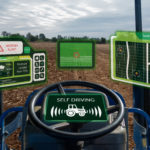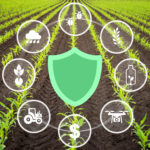
Mike J. Borel, Partner at The Context Network, spoke at the February 2022 Alliance of Chief Executives Roundtable, an online event that brought industry leaders together to share their insights on the future of food and agriculture. Borel summarized his point of view here:
Technology breakthroughs have a long history of changing and improving agriculture. From the advent of mechanization to the introduction of hybridization and chemical pest management to more recent developments in biologicals, biotech transformation and traits, precision ag, and data analytics, each significant shift has captivated the industry’s focus and, in effect, defined an era in agriculture.
What’s unique now is the remarkable number, convergence and pace of technology breakthroughs—any one of which could stand alone as a decade-defining innovation. Collectively, these simultaneous breakthroughs are ushering in an unprecedented, exciting time in agriculture.
When I think about the next five to ten years in our industry, there are five technology shifts I believe will have major, positive impacts. I’ll outline what’s currently happening with each of these breakthroughs—and why it matters for the future.
1. Data Integration, Data Analytics and Digitization

WHAT’S HAPPENING: Just look at the wealth of data generated on farms. It’s coming from tractors, planters, combines, soil testing, yield monitors, remote sensing, variable rate applications, and more. Then look at the vast amounts of data generated through marketing or operations or other business functions. The breakthrough that’s underway now is that all of this data—which has been in separate siloes—is coming together.
In the past, for instance, there was equipment data, chemical data, seed data, lending data and so on, but never the twain shall meet. With new technology platforms, multiple layers of data from different sources can be integrated and used to fuel analytics that produce valuable (often surprising) recommendations. These data-driven insights are helping producers and companies be better in countless ways—more productive, more profitable, more socially resonant and more environmentally beneficial.
WHY IT MATTERS: Clearly, there’s a great deal of interdependence between data integration and data analytics. The next big leap will be true digitization across every facet of the agricultural sector. Digitization is when we tap data to provide personalized choices and recommendations. Think about the consumer experiences we have in our personal lives, whether shopping in our favorite stores or online. Our past and real-time behavior and interests drive which items we’re presented with, how they’re delivered and so forth. Right now, agriculture is behind on the curve on digitization, but there’s no reason the industry can’t catch up. Rural access to broadband has been a limiting factor that’s slowed digitization in agriculture, but that’s changing with satellite and 5G.
2. Electrification, Machine Learning and Artificial Intelligence (AI)

WHAT’S HAPPENING: Autoguidance/autosteering is widely adopted. Enabled by this, robotics and smaller types of electric-powered equipment are expected to become increasingly important in production agriculture. This is possible because of seismic advances in the capacity and capability of computer chips that can perform computations on huge volumes of information in a matter of milliseconds. And with machine learning and AI, autonomous farm equipment gets better—smarter—with each use, based on the information it collects along the way. So, for instance, with each field pass, a small, unmanned robot tasked with selectively applying herbicides gets more intelligent, drawing not only from field data but from external data too.
WHY IT MATTERS: Many aspects of agriculture are labor intensive, and the shortage (and limitations) of human labor is helping drive these breakthroughs. It’s not about robots displacing people. Producers are having a difficult time finding and hiring the people needed for thinning and weeding and for harvesting fruit and vegetable crops. Thinning and weeding are activities that robots are exceptionally good at doing, and robotic harvesting is advancing rapidly, with increasingly sophisticated ability to not only detect, reach and pluck the crop, but to determine if it’s ripe and ready for harvest. Small and mid-sized equipment has other advantage: it’s lighter than conventional equipment, reducing soil compaction, can be deployed in multiples and is suited to diverse soil conditions.
In addition to practical labor and environmental implications, these breakthroughs empower producers in more profound ways. Insights can now be gleaned—and acted upon—in fields, in the moment. Producers today are managing complex operations, but they’re often doing this from the seat of a tractor or combine. As these technologies take hold, producers will be managers of operations, not operators of machinery.
3. Genetic Modification

WHAT’S HAPPENING: Genetic modification is already underway—and it’s poised to vault to new levels because of recent advancements in gene editing, trans genes, RNA interference (RNAi), and messenger RNA (mRNA).
In the early years of genetic modification, the industry tended to emphasize production benefits—which left consumers cold. That’s changed. Now, a number of gene-edited breakthroughs on the market have demonstrable benefits for consumers and producers alike: heart-healthy oils (high oleic soybeans), more nutrition-rich produce (high GABA tomatoes), animals with less need for antibiotics (pigs protected from PRRS), and weed-resistant crops that need fewer chemicals (SU canola). Within the U.S., gene editing still has a long runway because the USDA views it the same as conventional breeding techniques and therefore doesn’t impose additional regulations on it. That’s not the case in Europe, and regulations are still being decided in other key agricultural regions of the world.
Breakthroughs in trans genes are equally promising. One of the first FDA-approved food applications was a transgenic Atlantic salmon with one gene from the wild chinook salmon that enables the transformed Atlantic salmon to grow much faster. This advancement can help meet the rising demand for fish protein without diminishing stocks in the wild—and signals promise for future transgenic products. And I for one, love salmon—and potentially buying salmon nearer the price of chicken appeals to me!
Developments in RNA interference (RNAi) and messenger RNA (mRNA) are a whole new arena. There’s no better, more visible example of mRNA than the coronavirus vaccines that were developed in record time. Within food and agriculture, the potential applications are immense.
WHY IT MATTERS: Today’s consumers are sophisticated, informed, and vocal about their preferences. Genetic modifications can deliver exactly the kind of food products they desire, with safety and qualitative benefits that matter to them: healthiness, taste, and texture. Further educating consumers on the intensity of our regulatory systems that assure food safety is needed in order to overcome unfounded negative perceptions about gene editing and genetic modification.
4. Alternate Proteins

WHAT’S HAPPENING: The alternate protein market is just getting started. Right now, most people are familiar with plant-based burger replacements. What’s coming is a swell of interesting, new products like veggie-meat hybrid foods, plant-based egg substitutes, innovative and surprising plant milks (hello potato milk), tissue-cultured meat and fish products, and more.
WHY IT MATTERS: There’s no question that demand for protein is on the rise as the global population increases, and particularly, as the middle class expands in countries like China and India. Everyone agrees the population is expanding; the only question is whether it will reach 9.5 billion or 10 billion by 2050. It will be challenging, if not impossible, to meet that demand with animal agriculture alone. Beyond the driver of population growth, there is a growing body of “flexitarians” who are interested in plant-based and tissue-cultured options to animal protein. Will these alternate proteins displace or replace animal protein? No, I believe they’ll take a share of a growing market for protein. Fundamentally, there is more than enough demand for both animal protein and alternate proteins.
Right now, the cost of meat alternatives is still too high for many consumers. I’m confident going forward that technological developments and increased scale will help reduce cost. We’ll also see improvement in the taste, texture, and amino acid completeness of alternate proteins.
5. Next-generation Biologicals

WHAT’S HAPPENING: Biologicals for crop protection and crop enhancement have been around for a long time and are the only products accepted for organic production. Historically, however, they’ve been somewhat less effective than synthetic products. Therefore, while biologicals have been useful, they’ve posed certain limitations and challenges.
Next-gen biologicals refer to newly developed biocontrols for pest management and newly developed biostimulants for plant and soil health, fertilizer and water use efficiency, and more. New discovery and optimization techniques are dramatically improving the performance of biologicals, which I believe will put the efficacy of newer products on par with synthetics.
WHY IT MATTERS: Biocontrols and biostimulants are already prevalent in production agriculture–biocontrols particularly in horticultural crops and biostimulants in row crops. In the very near future, I believe next-gen biologicals will garner a much higher share of market in production agriculture. Within the U.S., the regulatory approval path for biologicals is much shorter and less onerous than for synthetics. As biologicals increasingly improve in efficacy, this will markedly alter the landscape for both crop protection and crop enhancement.
These five technology breakthroughs are already reshaping food and agriculture, and I expect continued, significant impacts across the value chain. I’d encourage you to consider how each of these shifts might align with or impact your business goals. It will also be important to consider these innovations through a consumer lens, as today’s consumers expect transparency and are vocal about their preferences. Now is the time to consider your own capabilities, investments and strategies. However advanced, these shifts are generally still in their formative stages, and there’s tremendous opportunity for stakeholders to secure leadership or to carve out a strong niche.
A message from Mike
At The Context Network, we’ve helped organizations identify trends and develop strategies for succeeding in changing environments for more than three decades. Through our deep business knowledge and broad network of agriculture experts, we can help you anticipate and plan for opportunities. To discuss or learn more about any of the breakthroughs I’ve touched on in this article, reach out to me at mike.borel@contextnet.com. My Context partners and I stand ready to help.
Mike J. Borel has revitalized, streamlined and turned around organizations to generate positive cash flow, increase market share, improve productivity and reduce costs. Mike has applied common sense and business skills to lead teams in outperforming competitors in sales and profits in every position he has held. He helps clients outperform competitors and achieve remarkable results.


